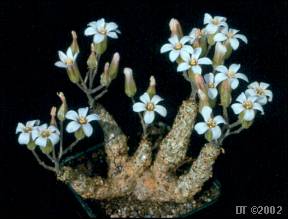| FREQUENTLY
ASKED QUESTIONS
6.
What plants are related to Adromischus?
The
genus Adromischus is part of the family Crassulaceae, one of very few families
that
consists almost entirely of succulent plants. For a
recent technical
view about how the Crassulaceae
fits with
other families as part of the Saxifragales
and other higher orders of seed plant
classification, visit the
Angiosperm Phylogeny
Website
by P. F. Stevens.
Traditionally,
the Crassulaceae was split into
six
subfamilies (Berger 1930). Recent molecular studies
reveal seven clades
(Mark Mort et al. in Am. J. Bot. 88:1 (2001) p. 76-91). The
Southern African genera Cotyledon
and Tylecodon are most closely related to Adromischus,
with the Eastern African and Madagascan genera Bryophyllum, Kalanchoe
and Kitchingia completing the
clade.
Historically,
the genus Cotyledon Linnaeus
(1753) was
described first. Adromischus
Lemaire
(1852) was not widely used for a long time and the
earlier species were
described as Cotyledon. Included
within Adromischus
were a few species of Tylecodon Tölken
(1978), before it was separated.
Adromischus
with 29 described species, contains squat to
spreading, dwarf to small
subshrubs with perennial, alternate leaves and a
rarely-branched
spike-like inflorescence with erect, spreading
flowers (except pendant
in A. phillipsiae). Commonly called
"Kleinplakkies" or "Bontplakkies" in Afrikaans.

The widespread Cotyledon orbiculata, about
18" (45
cm.) high in the Little Karoo, W. Ladismith.
Cotyledon
now with only 11 species, contains small, woody
shrubs with opposite
(or tri-merous), perennial leaves and a branched
inflorescence with
pendent flowers when open. Their centre of diversity
is in the Eastern
Cape but one species (C. barbeyi) has a
distribution from South Africa to East Africa.
Generally, they are
rather large for pot cultivation where heating is
needed. Commonly
called "Plakkies" in Afrikaans and some are known to
be poisonous to
livestock..

Tylecodon longipes, in a 2" (5 cm.)
pot, from the TL, Kloof of Caves, Richtersveld.
It flowers in the summer after the leaves have
shrivelled.
Tylecodon with about 45 species,
contains pachycaul, dwarf geophytes to shrubs (to
scramblers) with
deciduous, alternate leaves and a branched
inflorescence with usually
erect flowers when open. All are from Namibia and
South Africa, with a
centre of diversity in Namaqualand. New species are
still being found.
They are very suitable for pot cultivation, but slow
to propagate.
Full
information about Cotyledons and Tylecodons can be
found in the book by van Jaarsveld &
Koutnik.
|